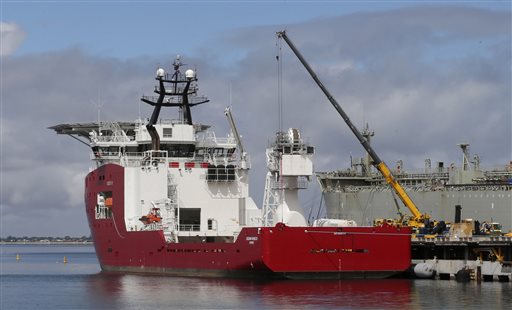SYDNEY - Thursday marked a bleak moment for Malaysia Airlines Flight 370. For the first time since it disappeared March 8 with 239 people on board, no one is looking for it.
An unmanned sub that spent weeks scouring the area of the Indian Ocean where searchers had detected acoustic signals they hoped were from the aircraft finished its work Wednesday, after finding nothing. Australian officials leading the search acknowledged that the area can be ruled out as the aircraft's final resting place.
A civilian expert with the U.S. Navy told CNN that the "pings," detected about a month after Flight 370 disappeared, probably were not from the jet. A Navy spokesman later said the comments were premature, but now that 850 square kilometers (330 square miles) of ocean floor have been thoroughly searched, the point may be moot.
Australian and Malaysian authorities still believe the plane is somewhere in a broader expanse of ocean close to where they had been searching. They released details this week of satellite contact with the jet that led them to that conclusion.
Answers to the tragic mystery appear to be months away - at best. Here are details about where the search stands:
Q: IF THE PINGS WERE NOT FROM THE PLANE, HOW DOES THAT AFFECT THE SEARCH?
A: Given that the head of the search operation, Angus Houston, once dubbed the pings the "most promising lead" in the hunt for Flight 370, a determination that they were unrelated would be a huge disappointment. But it wouldn't change the direction of the search. Officials have already been planning to move beyond the search area centered on the pings to a far larger search zone, which was calculated based on an analysis of satellite data. That plan remains in place.
Q: WHY IS NO ONE SEARCHING FOR THE PLANE NOW, AND WHEN WILL THE SEARCH RESUME?
A: The Bluefin 21, the unmanned sub that scoured the ocean floor for several weeks, finished its search on Wednesday. Officials now must find a vessel that can go even deeper than the Bluefin to survey the expanded search zone, parts of which have never been mapped and where the maximum depth remains a mystery. Officials must organize contracts for the new equipment with a private company. The Joint Agency Coordination Center, which is heading up the search effort, said the new search involving powerful towed side-scan commercial sonar equipment will begin in August.
Q: HOW BIG IS THE SEARCH AREA NOW, AND HOW LONG WILL IT TAKE FOR THE NEW EQUIPMENT TO COVER IT?
A: The search area is 56,000 square kilometers (21,600 square miles). Officials say it will take up to a year for the new equipment to thoroughly search the area.
Q: WHICH COUNTRIES ARE CONTRIBUTING TO THE SEARCH EFFORT, AND HOW?
A: Australia is coordinating the search. The Chinese survey ship Zhu Kezhen is mapping the ocean floor in the new search area, though it is not looking for the plane. Another Chinese ship, Haixun 01, and a Malaysian vessel, Bunga Mas 6, are transporting the survey data collected by the Zhu Kezhen each week to Fremantle, Western Australia, so experts can process it. The survey is expected to take about three months.
Q: HOW MUCH IS THE SEARCH EXPECTED TO COST, AND WHO IS PAYING?
A: Australia has budgeted 90 million Australian dollars ($84 million) for the search through June next year. Until now, each country involved in the search has been bearing its own costs. But Australian Prime Minister Tony Abbott said he will now seek contributions from other countries to help pay for the new equipment.
Q: WHAT HAS BEEN DONE, AND WILL BE DONE, FOR THE FAMILIES OF THE MISSING PASSENGERS?
Malaysia Airlines paid for family members to stay at hotels in Malaysia and China while they waited for news of the plane. Families were also given logistical and financial assistance, as well as individual caregivers for counseling and support. In early May, the assistance centers were shut down and family members were told to leave. The airline said it will keep in close touch with the families on news updates, though some family members say this has not been the case.
The airline has made advanced compensation payments to some families, but declined to reveal details. It has said such payments will not affect the rights of the next-of-kin to claim compensation according to the law at a later stage, and will be calculated as part of the final compensation.

